What Is an eLearning Developer? Everything You Need to Know

An excellent eLearning course doesn’t happen by chance — it’s designed and built by skilled eLearning developers who combine great design with technology. With the eLearning market projected to grow from $263.5 billion in 2023 to $933.5 billion by 2032 (Allied Market Research), demand for these professionals continues to rise. But what exactly does an eLearning developer do?
If you’re considering this career path or want to enhance your skills, this guide will give you a clear understanding of the role.
We’ll explore the key responsibilities, essential tools, and technologies used in eLearning development, as well as what it takes to create high-quality eLearning courses. Whether you’re starting out or looking to advance as an eLearning developer, you’ll find practical insights to help you succeed.
What Is an eLearning Developer?
An eLearning developer is a professional responsible for designing, developing, and delivering eLearning courses that make digital learning engaging and effective.
They transform educational content into interactive experiences using authoring tools, multimedia elements, and learning management systems (LMS).
How eLearning Developers Contribute to Digital Learning
By combining instructional design principles with technology, eLearning developers create structured, interactive training programs that enhance learner engagement. They work closely with subject matter experts (SMEs) and stakeholders to ensure that learning materials meet specific learning objectives. The work of an eLearning developer often includes:
- Developing eLearning modules with interactive elements like quizzes and simulations.
- Optimizing courses for mobile devices to improve accessibility.
- Enhancing learning experiences with video editing, audio editing, and graphic design.
- Implementing feedback loops to continuously improve eLearning design.
Industries that hire eLearning developers
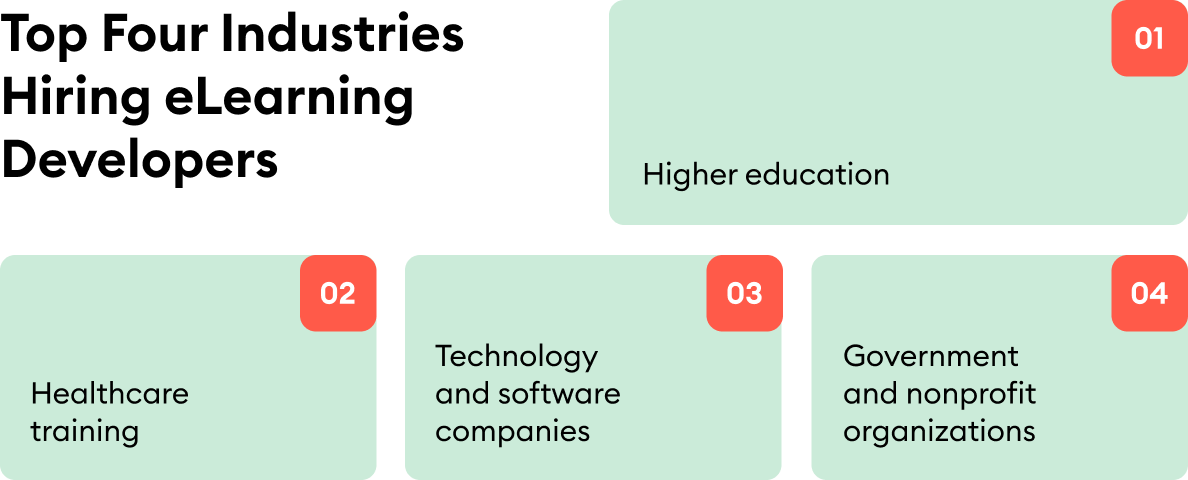
The demand for eLearning content developers has grown across various industries, including:
- Higher education – Universities and colleges integrate eLearning development into degree programs.
- Healthcare – Digital training ensures compliance and up-to-date medical knowledge.
- Technology and software companies – Developers create training materials for new software and tools.
- Government and nonprofit organizations – Used for compliance training and professional development.
As digital learning continues to expand, the role of an eLearning course developer is becoming increasingly essential across different sectors.
Key Responsibilities of an eLearning Developer
An eLearning developer plays a crucial role in creating engaging and effective digital learning experiences. Their work goes beyond just assembling course content — they design, develop, and optimize eLearning courses to ensure engagement, usability, and knowledge retention.
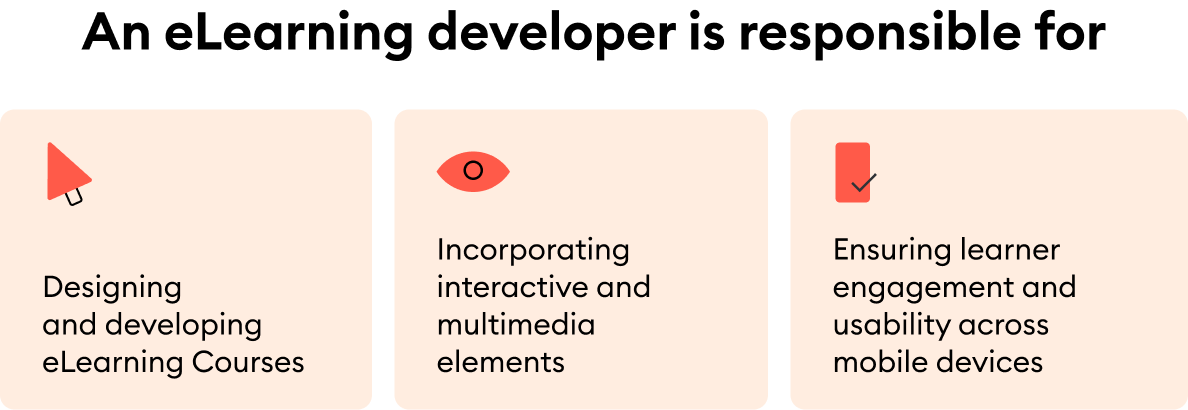
Designing and developing eLearning courses
The primary task of an eLearning course developer is to build structured, interactive learning experiences. This involves:
- Using eLearning development software like iSpring Suite, Articulate Storyline, and Adobe Captivate.
- Creating visually appealing eLearning modules with a strong user experience design.
- Structuring content to align with clear learning objectives.
- Ensuring that courses are optimized for various mobile devices.
- Collaborating with subject matter experts and stakeholders.
An eLearning content developer doesn’t work alone. They partner with subject matter experts (SMEs), instructional designers, and corporate leaders to create accurate and engaging training materials. Key collaboration tasks include:
- Gathering content and translating complex topics into digestible lessons.
- Aligning courses with business goals and compliance requirements.
- Implementing learner feedback to improve course effectiveness.
Incorporating interactive and multimedia elements
To create engaging learning experiences, eLearning developers integrate a variety of multimedia elements, including:
- Interactive elements like quizzes, drag-and-drop activities, and simulations.
- Video editing and audio editing for enhanced learning experiences.
- Graphic design tools to create professional visuals.
- Virtual reality and other immersive technologies for advanced training scenarios.
Ensuring learner engagement and usability across mobile devices
A well-designed eLearning course should be accessible and engaging across different platforms. eLearning developers focus on:
- Optimizing content for mobile devices to support on-the-go learning.
- Enhancing navigation and usability for a smooth learning experience.
- Implementing best practices in eLearning design to improve retention and engagement.
By balancing creativity, technical skills, and strong project management skills, eLearning developers ensure that digital learning is both effective and engaging.
eLearning Developer vs. Instructional Designer: Key Differences
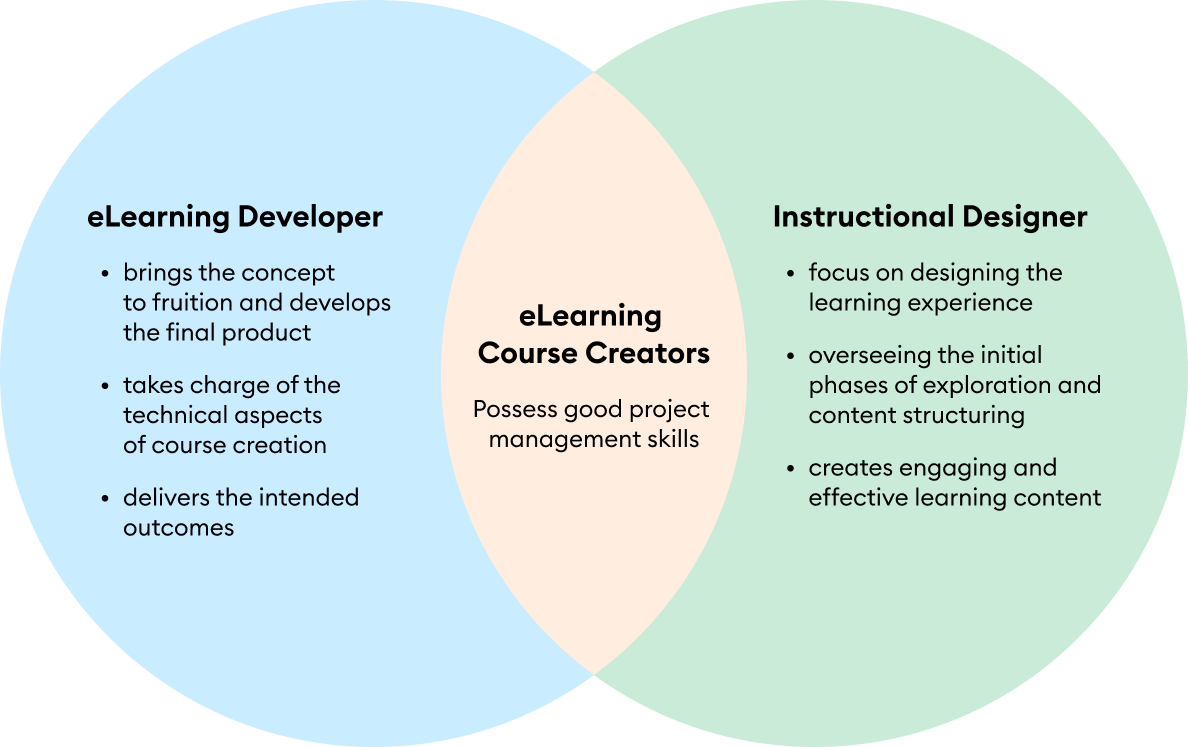
While both roles contribute to eLearning development, their focus areas differ:
- Instructional designers specialize in learning design and structuring content based on learning objectives and pedagogy. They work on course frameworks, assessments, and engagement strategies.
- eLearning developers handle the technical side, using digital course builders, multimedia elements, and interactive elements to build and deliver digital courses.
In many organizations, these roles overlap, requiring professionals to have both instructional design knowledge and technical skills in eLearning design.
How to Become an eLearning Developer
Becoming an eLearning developer involves having a combination of education, technical skills, and hands-on experience. While there is no single path to enter this field, professionals typically build expertise in eLearning design, instructional design, and multimedia development through formal education, certifications, and real-world projects.
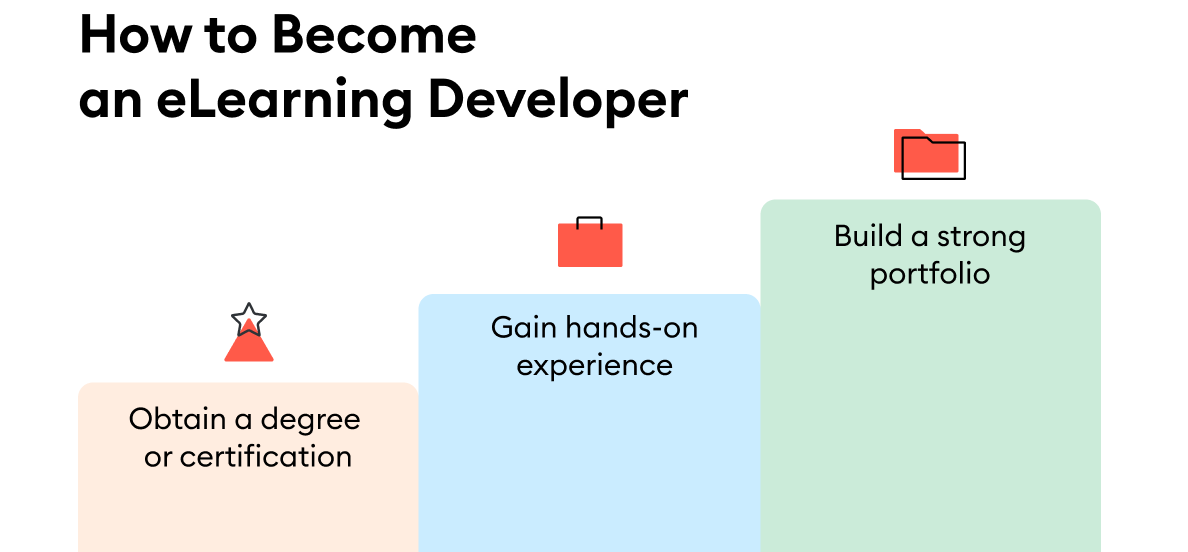
Degrees and certifications
There is no strict degree requirement for an eLearning developer position, but a background in education, graphic design, computer science, or instructional design can be beneficial. Common pathways include:
- University degree – Fields such as instructional design, educational technology, or multimedia production provide a strong foundation.
- Alternative learning paths – Many professionals transition from teaching, graphic design, or software development, acquiring skills through online education and self-study.
- Professional certifications – Earning certifications in eLearning creation software like Articulate Storyline, Adobe Captivate, or iSpring Suite helps validate expertise and improve job prospects.
Gaining experience and building a portfolio
Practical experience is key to standing out in the job market. Beginners can start by:
- Taking entry-level positions – Many companies offer junior or entry-level positions in eLearning development, instructional design, or content creation.
- Working on freelance projects – Platforms like Upwork and Fiverr allow new developers to gain experience creating eLearning courses for clients.
- Building a strong portfolio – Showcasing real-world eLearning modules, interactive elements, and multimedia work is crucial. A strong portfolio demonstrates technical expertise, creativity, and the ability to develop engaging learning materials.
By combining education, industry-specific skills, and hands-on experience, aspiring eLearning content developers can successfully enter and grow in this dynamic field.
Must-Have Skills of eLearning Developers
A successful eLearning developer needs a mix of technical skills, design expertise, and soft skills to create engaging, high-quality eLearning courses. Here’s a breakdown of the essential competencies:
Technical skills
eLearning developers work with various tools and platforms to design, build, and manage eLearning modules. Essential hard skills include:
- eLearning development software – Proficiency in iSpring Suite, Articulate Storyline, and Adobe Captivate for creating interactive content.
- LMS administration – Managing and integrating content within learning management systems like iSpring Learn.
- Video editing and audio editing – Using tools like Adobe Premiere Pro and Adobe Audition to enhance multimedia content.
- Basic coding skills – A working knowledge of HTML5, CSS, and JavaScript can be helpful to customize eLearning courses.
Design skills
Visual appeal plays a crucial role in learner engagement. eLearning developers should have:
- Graphic design expertise – Experience with Adobe Photoshop, Illustrator, Figma, or Canva for creating high-quality visuals.
- User experience design – Structuring courses to ensure accessibility and ease of navigation.
- Capacity with interactive elements – The ability to incorporate quizzes, simulations, and multimedia elements for an engaging learning experience.
Soft skills
Beyond technical expertise, eLearning developers need strong communication and project management abilities to work effectively in corporate settings. Key soft skills include:
- Project management skills – Balancing multiple deadlines and coordinating with stakeholders.
- Communication skills – Collaborating with subject matter experts, instructional designers, and leadership teams.
- Problem-solving mindset – Identifying areas for improvement and integrating learner feedback into course updates.
By combining these technical skills, visual design expertise, and soft skills, eLearning content developers can create high-impact training solutions that meet corporate and educational needs.
Essential Tools for eLearning Development
To create engaging and effective eLearning courses, eLearning developers rely on a variety of tools for content creation, multimedia production, and LMS administration. Here are the essential tools every eLearning content developer should be familiar with.
Authoring tools
These are the backbone of eLearning development, allowing developers to create interactive courses with digital elements, quizzes, and simulations. Popular choices include:
- iSpring Suite – A user-friendly authoring tool that integrates with PowerPoint seamlessly for rapid eLearning design.
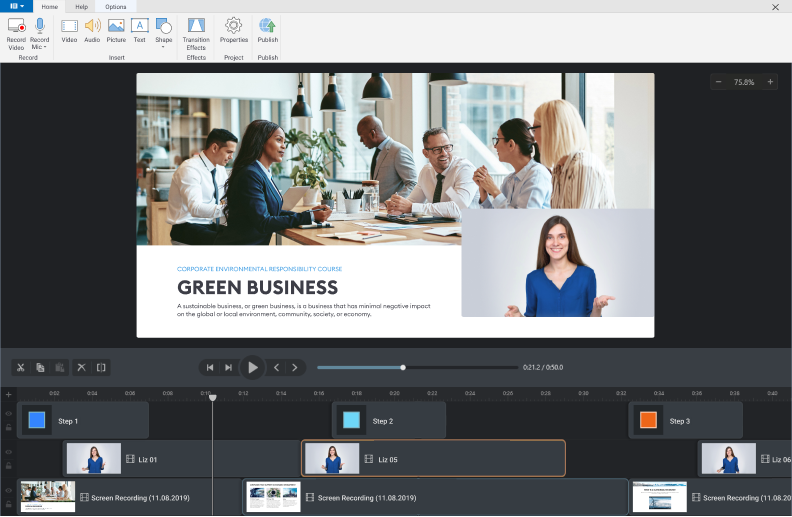
- Articulate Storyline – A flexible tool for building interactive elements and branching scenarios.
- Adobe Captivate – Ideal for creating responsive eLearning modules that work across mobile devices.
Multimedia tools
High-quality audio editing, video editing, and graphic design are crucial for professional-looking eLearning courses. Key tools include:
- Adobe Premiere Pro – A powerful option for video editing and creating polished training content.
- Adobe Audition – Used for audio editing, voice-overs, and sound enhancement.
- Camtasia – A screen recording and video editing tool, ideal for software tutorials and demonstrations.
LMS platforms
A learning management system (LMS) is essential for delivering, tracking, and managing eLearning courses. Common LMSs include:
- iSpring Learn – A robust LMS with user-friendly administration, analytics, and mobile compatibility.
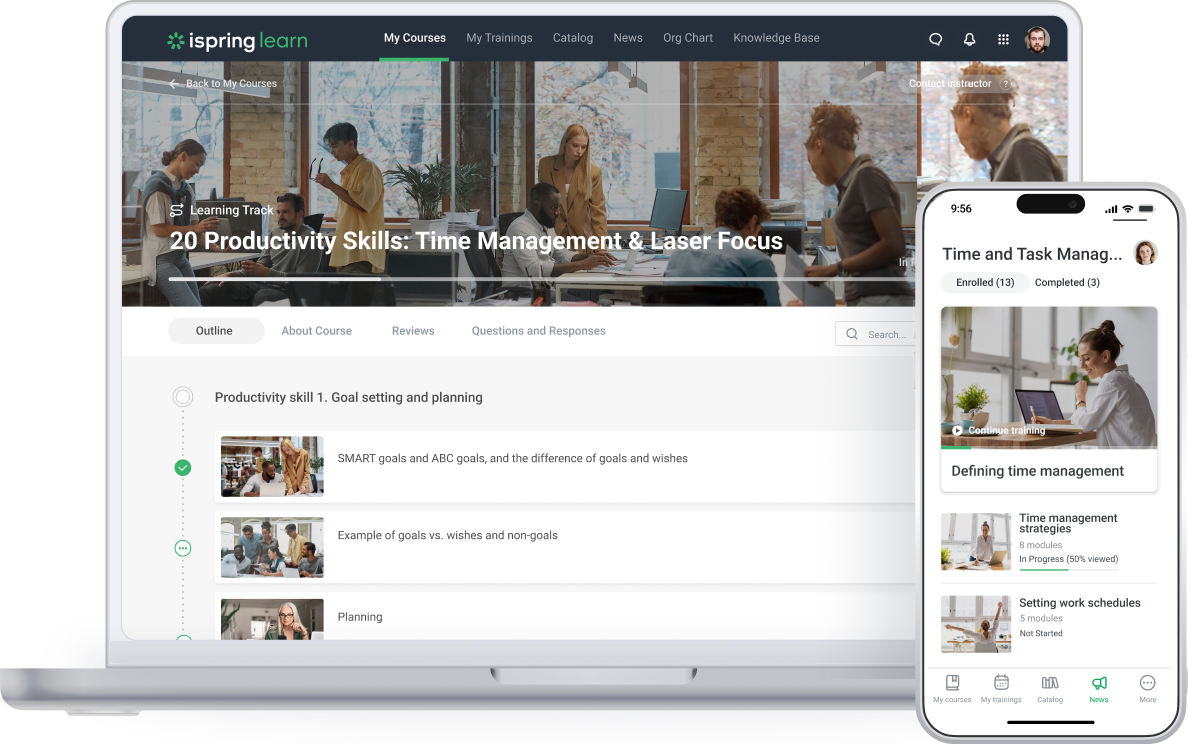
- Moodle, Docebo, and TalentLMS – Widely used platforms for corporate and educational training.
Mastering these tools helps eLearning course developers create high-quality content, ensuring a seamless learning experience for professionals and students.
Career Growth and Professional Development
A career as an eLearning developer offers numerous opportunities for advancement, allowing professionals to specialize, take on leadership roles, and stay at the forefront of eLearning development. Here’s how to grow in this dynamic field:
Advancement in the corporate world
As eLearning developers gain experience, they can move into higher-level roles, such as:
- Senior eLearning Developer – Leading projects and mentoring junior team members.
- Learning Experience Designer – Focusing on learner engagement and course interactivity.
- Training Manager or Director – Overseeing eLearning design strategy and implementation at an organizational level.
Specialization paths
Many eLearning content developers choose to specialize in specific areas to enhance their expertise:
- Learning Design – Focus on learning objectives, instructional strategies, and user experience design.
- Content Design – Development of high-quality study materials with graphic design tools and media elements.
- LMS Administration – LMS management, handling of access control, and ensuring smooth course delivery.
Staying up to date with eLearning trends
The field of eLearning development is constantly evolving. To remain competitive, professionals should:
- Follow industry blogs, webinars, and conferences on best practices.
- Obtain advanced certifications in eLearning creation tools, visual design, or virtual reality.
- Engage in networking and professional groups to collaborate with other eLearning developers effectively.
With the right approach to professional development, eLearning developers can expand their skill sets, take on leadership roles, and help shape the future of online education and corporate training.
Wrapping Up
The role of an eLearning developer is both dynamic and in high demand as organizations continue to invest in online courses and digital learning solutions. Whether designing interactive elements, collaborating with subject matter experts, or mastering the latest course development software, eLearning developers play a crucial role in modern education and corporate training.
To succeed in this field, professionals need a mix of technical skills, strong communication skills, and project management expertise. By staying updated on best practices and investing in professional development, eLearning content developers can advance their careers and make a lasting impact.
For those looking to create high-quality eLearning courses, tools like iSpring Suite and iSpring Learn provide everything needed for eLearning design, LMS administration, and engaging content development. Whether you’re starting out or want to enhance your skills, these solutions can help you build effective and interactive learning experiences.







